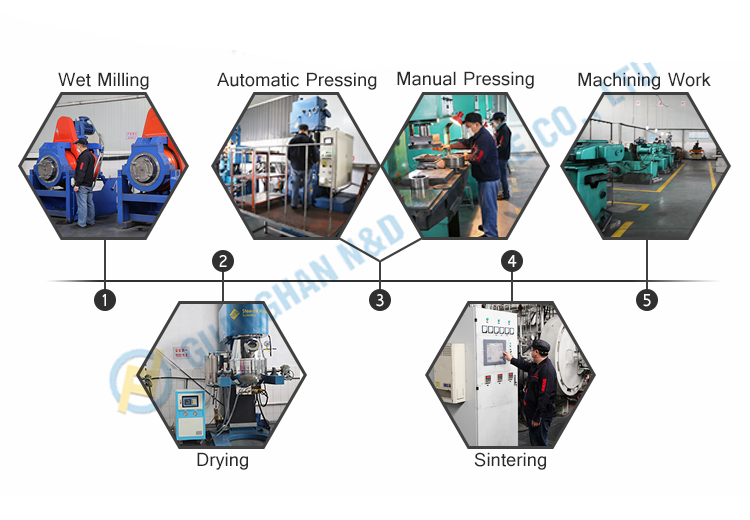Metallized Carbon Corporation, Ossining, New York
Modern mechanical carbon materials are being used in a wide variety of applications, including aircraft gear boxes, air turbine motor starters, and main shaft seals for both aircraft turbine engines and aircraft auxiliary power units (APUs). These self-lubricating materials are composed of fine-grained electrographite substances that are impregnated with proprietary inorganic chemicals to improve their lubricating qualities and oxidation resistance. These modern carbon-based materials are ideal for use in aircraft applications because of their low coefficient of friction, low wear rate at high sliding speed, high thermal conductivity, and resistance to oxidation in high-temperature air. Tungsten Carbide Nozzles

Aircraft gearboxes are used to reduce the main engine shaft’s rotational speed from as high as 26,000 rpm down to about 3,400 rpm, so the shaft can drive system components such as hydraulic pumps, generators, and air conditioning compressors. To seal the oil lubricant within the gearbox and protect it from leaking out at the point where the shaft enters and exits the gearbox, most aircraft gearboxes use face seals. The face seals usually contain a carbon-graphite stationary ring and a silicon carbide or tungsten carbide rotating ring. The rings that make the dynamic face seal are both lapped flat and held together with springs or magnets so that liquids cannot flow between the ring faces, even though they are spinning against each other at high rpm (Figure 1).
The two rings in relative motion that make the dynamic seal are sealed to the shaft or the gear box housing with static seal rings such as polymeric O-rings. Seal designers use spiral grooves, straight grooves, and wedges to channel or pump a thin film of air or oil between the two sliding sealing faces. This creates aerodynamic or hydrodynamic lift, which greatly reduces the friction and wear of the seal faces.
Air turbine motor starters typically use the same carbon-graphite versus silicon carbide or tungsten carbide dynamic face seal materials that are used in gearbox seals, but the sliding speed is much higher. These air turbine motor starters are actually small turbines that use the exhaust gas from the auxiliary power unit to create the power necessary to start the main engines.
The shaft speed on air motor starters can be as high as 180,000 rpm, or a sliding speed of about 1000 ft/s, which is nearly the speed of sound. The seals are designed by aircraft seal manufacturers with wedges and gas flow passages to produce aerodynamic or hydrodynamic lift-off.
Face seal rings, with carbon-graphite primary rings, and carbon-graphite circumferential seal rings are used in aircraft engine main shaft seals to control the airflow and combustion gas flow inside the engine (Figure 2). They also seal the oil lubricant in the main engine bearings that allow the compressor shaft and the combustion gas turbine shaft to rotate freely. Both circumferential and face type seal rings are used.
For circumferential main shaft seal rings, carbon-graphite segments that fit with close end clearance in slots in the stationary housing are used. The carbon-graphite segments are tensioned against a ceramic or hard metal coating on the rotating shaft using a “garter” spring. Lifting wedges and machined configurations are used to create lift so that these seals run on an aerodynamic or hydrodynamic film. Rotating speeds can be as high as 26,000 rpm, and temperatures in the seal rings can reach as high as 800 °F.
Auxiliary power units (APUs) are small gas turbine engines that are used to create electric power, air conditioning, or cabin heat when the main engines are turned off at the gate to save fuel. APUs contain carbon-graphite seals that are similar to, but smaller than, main engine seals.
Oil-free, self-lubricating mechanical carbon materials have a unique combination of characteristics that makes them ideal for use in both commercial and military aircraft seal applications. The materials are self-lubricating, self-polishing, and dimensionally stable, which insures a good sealing mate. The materials are heat-resistant and have a high thermal conductivity, which helps conduct frictional heat away from the sliding surface. In addition, these materials are readily machinable to exacting aerospace dimensional tolerances, and they can be supplied lapped and polished to a flatness specification of one helium light band.
This article was written by Glenn H. Phelps of Metallized Carbon Corporation. For more information, Click Here
This article first appeared in the September, 2015 issue of NASA Tech Briefs Magazine.
Read more articles from this issue here.
Read more articles from the archives here.
10 VR/AR Technologies from CES 2023
NIF Laser Systems Chief Engineer to Discuss Historic Fusion Ignition...
Adding Vibrations to Electronics to Reduce Vibrations
Thermal Modeling of Small Satellites
Better Products in Less Time: How Automation and Optimization Take CAE to the Next Level
Flexible Technology and Material Options for Automotive Capacitive Sensors
EV Motor Improvement With Torque-Dense Materials and Advanced Powertrain Technology
Extending ICE Life for Commercial Vehicles
Future Trends and Challenges for Connector Solutions in Industrial and Commercial Vehicles
Conformal Coatings for Product Reliability and Long-term Performance
Thermal Modeling of Small Satellites
Process Converts Ethanol to Jet Fuel
NASA Energy Concept Could Harness the Power of Ocean Waves
Infrared Cameras Support Advanced 3D Printing Efforts
Tech Briefs - January 2023 - Vol. 47 No. 1
By submitting your personal information, you agree that SAE Media Group and carefully selected industry sponsors of this content may contact you and that you have read and agree to the Privacy Policy.
You may reach us at privacy@saemediagroup.com.
You may unsubscribe at any time.

Decanter Centrifuge Tips © 2009-2023 Tech Briefs Media Group